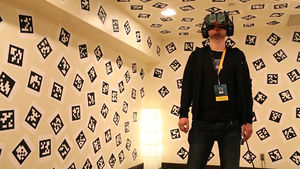Difference between revisions of "Markerless, inside-out tracking"
(→Markerless, inside-out tracking Systems) |
|||
| Line 39: | Line 39: | ||
[[Windows MR Tracking]] - [[Microsoft]] | [[Windows MR Tracking]] - [[Microsoft]] | ||
| − | [[WorldSense]] - [[Google]] | + | [[WorldSense]] - [[Google]] - inside-out tracking system for standalone [[Daydream]] headsets |
==References== | ==References== | ||
Revision as of 19:41, 11 June 2017
Contents
Introduction
Markerless, inside-out tracking is a composite term derived from two separate concepts, and refers to a method of tracking objects in three dimensional space.
'Marker-less' refers to the lack of fiducial markers used in this type of tracking, while 'Inside-Out' refers to the method by which data is gathered for the tracking.
Marker-less Tracking
Because of the difficult computations required for a software to interpret live camera input, tracking solutions that rely on cameras sometimes place fiducial markers (which may look like QR codes), in view of the tracking camera. This gives the software a known pattern to look for, which makes computation simpler and faster.
Thus the term, 'marker-less' refers to a system that is robust enough that it does not need the aid of printed markers to aid in its interpretation of the three dimensional space.
Inside-Out Tracking
Tracking systems that make use of a camera may be organized into two main branches, 'inside-out' and 'outside-in' tracking. Both terms refer to the placement of the tracking camera itself, with reference to what it is tracking.
In an 'inside-out' system, the tracking camera is placed within the item being tracked (for our purposes, like a head mounted display), from which vantage point it look out at the world around it. It uses its changing perspective on the outside world to note changes in position.
In an 'outside-in' system, a tracking camera is (or cameras are) placed around the space within which the tracked object will move, and use their changing view of the object itself to measure its changes in position.
Relative Merits
Both systems have merits; 'inside-out' tracking is notable because it can require no outside equipment, which is ideal for a portable device. Unfortunately, in the case of a headset, it places the burden of computation on the headset itself. (A burden which is exacerbated when no fiducial markers are used.)
'Outside-in' tracking can be less computationally demanding, and can make use of multiple cameras to make results more stable and consistent. This comes in part from the reduced chance of occlusion. Unfortunately it requires a controlled environment and more extensive equipment.
Markerless, inside-out tracking Devices
Markerless, inside-out tracking Systems
Windows MR Tracking - Microsoft
WorldSense - Google - inside-out tracking system for standalone Daydream headsets
References
- ↑ Youtube, Video: 'Steam Dev Days', on Channel: Valve, Published on Feb 11, 2014
